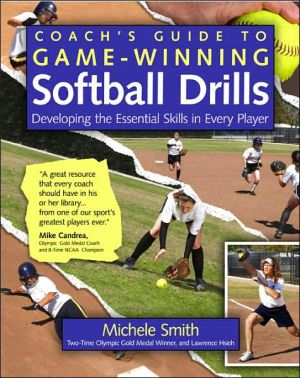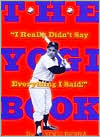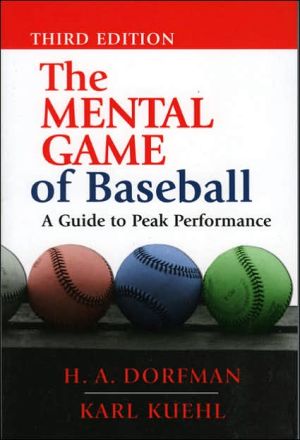Coach's Guide to Game-Winning Softball Drills
“Mastering these drills will arm your players with one of the biggest intangibles necessary to perform well—confidence.”\ —Michele Smith\ Two-time Olympic gold medalist and Hall of Fame pitcher Michele Smith throws one right down the middle with this big collection of more than 250 skill-building drills developed especially for coaches of fast-pitch recreation league, travel ball, and high school softball players, ages eight to eighteen.\ Straight from the Michele Smith Gold Camps and...
Search in google:
“Mastering these drills will arm your players with one of the biggest intangibles necessary to perform well—confidence.”—Michele SmithTwo-time Olympic gold medalist and Hall of Fame pitcher Michele Smith throws one right down the middle with this big collection of more than 250 skill-building drills developed especially for coaches of fast-pitch recreation league, travel ball, and high school softball players, ages eight to eighteen.Straight from the Michele Smith Gold Camps and Clinics, these drills are designed to give you all the tools you need to teach the entire range of offensive and defensive softball skills. With Michele's expert guidance and instruction, you'll coach your players to:Master the mechanics of footwork for fielding with hustle Swing for the fences and hit the fastest pitches Catch the ball proactively and throw it quickly and accurately to its target Defend the infield and outfield with speed and confidence Run the bases swiftly and strategically Refine fast-pitch skills so they can windmill like Michele And much moreMichele Smith has won two Olympic gold medals with the U.S. National Softball Team and was inducted into the American Softball Association Hall of Fame. An ESPN commentator for the Little League World Series, she runs popular softball clinics through her company, Michele Smith Inc. (michelesmith.com). She lives in St. Petersburg, Florida.Lawrence Hsieh is a writer, an attorney specializing in sports law, and a volunteer youth sports coach.
COACH'S GUIDE TO GAME-WINNING Softball Drills\ Developing the Essential Skills in Every Player \ \ By Michele Smith Lawrence Hsieh \ McGraw-Hill\ Copyright © 2008 Michele Smith and Lawrence Hsieh\ All right reserved.\ ISBN: 978-0-07-148587-6 \ \ \ Chapter One\ Throwing and Catching \ Great defense starts with good catching and throwing mechanics. When these are executed with speed, precision, and confidence, plus proper fielding footwork (Chapter 2), the defense stands a reasonable chance of making the play. When these skills are executed with improper mechanics and in pedestrian fashion, the defense will be more likely to commit errors and cede extra bases.\ Catching Mechanics\ Catching is proactive, not passive. Not every ball thrown, and very few hit, will be delivered straight to the fielder's glove. In game situations, players must use proper fielding footwork to hustle to a hit ball or to get off the bag to reach errant throws. Assuming the player has gone as far as she can using her feet, then she must be able to move her glove properly into position to catch the ball.\ Once her glove is in position, she should do the following:\ Watch the ball into her glove. She should not turn away.\ Keep her glove fingers pointing to the ball. When the ball is thrown above the waist, this means the fingers of the glove will be pointing up, and when the throw is below the waist this means the fingers will be pointing down.\ Catch the ball using two hands—meaning with her glove, of course, but also with her throwing hand right next to or just behind the webbing of her glove.\ Cover the ball with her throwing hand to keep it from popping out of her glove.\ Bring both arms in to her body as she catches the ball. This cushioning action is called soft hands. Soft hands will help prevent fumbles and put the fielder in position to make the throw.\ Bring both her glove and throwing hand to her throwing-side ear and transfer the ball to her throwing hand.\ Find the proper grip on the ball (as described later in this section) and make the throw to her target.\ Throwing Mechanics\ Proper throwing mechanics are designed to harness the energy needed to quickly and efficiently deliver a fast throw that is on target. When throwing, the player's movements should be quick, smooth, and confident. In a game situation, a player typically throws after catching or fielding the ball. After a smooth transfer of the ball from her glove to her throwing hand, she must execute the proper grip, lower-body movement, arm action, hip and trunk rotation, and release and follow-through as described in the following sections.\ Grip\ The player should hold the ball with her fingertips, not her palm. She should grip the ball along its horizontal seams (look for the ITLITL—that is, across the "smile" of the ball), with her middle fingertip at about 12 o'clock on the ITLITL and her other fingertips on the upper part of the ITLITL, and place her thumb on the opposite side of the ball. With practice, this reliable grip will become second nature.\ Lower-Body Movement\ As she begins her throw, the player should keep her back foot perpendicular to her target and stride forward with her nondominant foot, landing it at a 45-degree angle a comfortable distance toward her target. The nondominant foot is the foot opposite the throwing side (the left foot for right-handed throwers, and the right foot for left-handed throwers). The stride will cause her body to turn sideways to the target, in position to make the powerful hip and trunk rotation used to whip her throwing arm forward.\ Arm Action/Hip and Trunk Rotation\ Simultaneously with her stride, the player should draw her throwing arm back and point her glove arm toward her target. She should keep her throwing-arm elbow high so that her elbow and armpit both form 90-degree angles. She should make sure when the ball is behind her that her hand is on top of the ball (if she looks back, she should see her hand and not the ball). At this point her entire body and extremities should be on a vertical plane in line with her target.\ Release\ To execute the throw, the player must rotate her hips and trunk while whipping her throwing arm forward. Her back foot will naturally pivot from the original perpendicular position. She must take care not to push the ball like a shot put, but rather use her elbow as a pivot to smoothly fling the ball. The motion should be smooth; some kids have the tendency to "wind up" the arm and then freeze for a split second before throwing—these throws usually end up being overthrown or off target. She will then release the ball and follow through by pointing to her target. Her hands should naturally exchange positions.\ Fielding Mechanics: Ground Balls and Fly Balls\ As the ball is pitched, each defensive player should get into an athletic stance—with knees flexed and weight slightly forward on the balls of her feet, which are slightly more than shoulder-width apart, with a slight lean at the waist. She should position her hands close together in front of her body. She is now in her ready stance.\ If a ground ball is hit, she should do the following:\ Hustle into position using proper fielding footwork (see Chapter 2).\ Resume her athletic stance.\ Put her glove down between her legs, but in front of her body.\ Play the roll, and not the bounce. The default position should be glove on the ground; keeping the glove up in anticipation of a bounce will result in too many balls rolling between her legs.\ Watch the ball into her glove. She should not turn away.\ Cover the ball with her throwing hand to keep it from popping out of her glove.\ Bring both arms in to her body up toward her belly button (another soft hands technique).\ Bring both her glove and throwing hand to her throwing-side ear and transfer the ball to her throwing hand.\ Find the proper grip on the ball as described in the preceding section and make the throw to her target.\ If, despite best efforts, she is not able to hustle in front of the ball with proper footwork, she will need to resort to making a forehand or backhand grab. Forehand and backhand grabs are methods of fielding ground balls to be used when there is no longer enough time to get the body completely in front of and square to the path of the ball. The mechanics of making these grabs are described below.\ To make a backhand grab, she should do the following:\ Approach the ball with the glove side of her body so that she will field the ball with her glove-side leg closest to the ball; this will allow her to reach farther, if necessary.\ As she approaches the ball, drop her throwing-side knee toward the ground (her glove-side leg is in front). At the same time, she should rotate her glove-side knee, pointing at the throwing-side foot, which will allow her body and glove to rotate better.\ As she approaches the ball, drop her glove to the ground (thumb and webbing down) and remember to keep the glove open.\ Field the ball in front of her glove-side foot.\ Forehand grabs are similarly executed but with the thumb part of her glove on top because she still wants to field the ball on the glove side of her body.\ If a fly ball is hit, she should do the following:\ Hustle into position using proper fielding footwork (Chapter 2).\ Catch the ball above her forehead with two hands (arms not stiff, elbows bent), meaning she should position her throwing hand near the pocket of her glove to keep the ball from falling out of her glove and to facilitate a smooth transfer of the ball to her throwing hand.\ Bring both arms down toward her throwing-arm shoulder (yet another soft hands technique).\ Bring both her glove and throwing hand to her throwing-side ear and transfer the ball to her throwing hand.\ Find the proper grip on the ball as described earlier and make the throw to her target, using the crow hop (see Chapter 2) if necessary.\ Throwing and Catching Drills\ 1. One-Knee Throwing (Beginner)\ Purpose: To practice basic upper-body throwing mechanics\ Equipment: Safety ball or tennis ball\ Number of players: 2\ Number of repetitions: 20 reps for 2 sets\ Allocated time: 5 minutes\ Parent-friendly drill:\ \ \ \ Cardio index: [??]\ 1. Two players kneel on their dominant knee (i.e., throwing side), facing each other, 10 to 15 feet apart.\ 2. The players throw the ball to each other using proper upper-body throwing mechanics.\ 3. The players catch the ball using two hands (no glove), thus reinforcing soft hands technique.\ Advanced Variation\ Increase distance to 20 to 25 feet. Although the throwing mechanics are the same for longer throws, the player must rotate her hips slightly and her shoulder faster and whip her throwing hand faster from behind her throwing-side ear to generate the velocity to cover the longer distance.\ Hints\ Make sure your players rotate their throwing-side shoulder away from the target and bring their throwing hand past the ear before beginning the forward motion toward the target. Don't take the catching part for granted. Your players should use the soft hands technique to catch the ball.\ 2. 90-Degree Throwing (Beginner)\ Purpose: To practice proper arm position in throwing the ball\ Equipment: Safety ball or tennis ball\ Number of players: 2\ Number of repetitions: 20 reps for 2 sets\ Allocated time: 5 minutes\ Parent-friendly drill:\ \ \ \ Cardio index: [??]\ 1. Two players stand facing each other 15 feet apart.\ 2. One player holds the ball so that both her elbow and armpit are at about 90-degree angles.\ 3. A coach checks position and gives the signal for her to throw to the other player.\ 4. The player throws the ball to the other player using proper mechanics.\ 5. The players take turns throwing to each other in this manner.\ Advanced Variation\ Increase distance to 25 feet.\ Hints\ This drill will help correct the tendency of many players to "shot put" the ball. Shot-putting a ball will decrease power and accuracy. These drills are also great for warming up the shoulder while working on proper form.\ 3. Nondominant Foot (Beginner)\ Purpose: To practice basic throwing stepping with the nondominant foot\ Equipment: Softball or safety ball\ Number of players: Up to 4\ Number of repetitions: 15 reps for 2 sets\ Allocated time: 3 to 5 minutes\ Parent-friendly drill:\ \ \ \ Cardio index: [??]\ 1. Up to four players stand on the foul line facing a coach 15 feet away.\ 2. The player with the ball stands with her nondominant (glove-side) foot slightly forward.\ 3. The player then steps forward with her nondominant foot to complete the throw.\ 4. The coach catches the ball and throws it to the next player in line.\ 5. The player catches the ball using soft hands and repeats the drill.\ 6. Repeat until the allocated time elapses.\ 4. Catching—Up/Down Glove Position (Beginner)\ Purpose: To practice catching balls thrown low or high\ Equipment: Softball or safety ball\ Number of players: 3\ Number of repetitions: 10 reps for 2 sets\ Allocated time: 3 to 5 minutes\ Parent-friendly drill:\ \ \ \ Cardio index: [??]\ 1. Three players line up on the foul line about 5 feet from each other and facing a coach 15 to 20 feet away. Each player assumes her ready stance to catch the ball.\ 2. A coach throws the ball to each player, alternating throwing above and below waist level.\ 3. The player rotates her glove hand so her fingers are pointed down to catch balls thrown below her waist and fingers up to catch balls thrown above her waist.\ 4. Repeat until the allocated time elapses.\ Hints\ In game situations, fielders should take the explosive first step toward a ball hit in front of them and try to catch the ball with the glove up. If despite best efforts a fielder can't reach the ball before it falls below waist level, then she should turn her glove. In other words, a player should move feet first and hustle to the ball so the catch can be made as close as possible to eye level, where the player can see the ball.\ 5. Catching—Left/Right Glove Position (Beginner)\ Purpose: To practice catching balls thrown to the glove side or throwing side\ Equipment: Softball or safety ball\ Number of players: 3\ Number of repetitions: 10 reps for 2 sets\ Allocated time: 3 to 5 minutes\ Parent-friendly drill: Work on this drill one-on-one with your child.\ Have her stand in place or sit on a bucket. Throw balls to either side of her. In a game situation, she may need to get off the bag to catch an errant throw to prevent extra bases, but for this drill, encourage her to move her glove to get the ball.\ Cardio index: [??]\ 1. Three players line up on the foul line about 5 to 7 feet from each other and facing a coach 15 feet away. Each player assumes her ready stance to catch the ball.\ 2. A coach throws the ball to each player, alternating throwing to the glove-side or throwing-arm side.\ 3. The player's glove crosses the midline of her body to catch balls thrown to her throwing side.\ Advanced Variation\ Throw some overhead or short hops to really challenge advanced players. Good glove control is important for good fielding.\ Hints\ Errant throws are common in junior softball. Use this drill to help infielders catch balls thrown to either side. Sometimes an infielder has to get off the bag to catch errant throws, but the feet will only get the player so far, and she may need to maneuver her glove to catch the ball. Make sure your players start with both hands and fingers spread to make a catch, similar to a good position to catch a basketball.\ 6. Catching—Quick Reaction (Intermediate)\ Purpose: To develop quick reaction time for catching balls\ Equipment: Safety ball\ Number of players: 1 player or a group of players\ Number of repetitions: 15 reps for 2 sets\ Allocated time: 5 minutes\ Parent-friendly drill:\ Cardio index: [??]\ 1. Players line up facing a coach 30 feet away.\ 2. The coach signals for the first player to execute the drill.\ 3. The player steps forward so that she is about 15 feet from the coach and turns around so that she is not facing the coach.\ 4. The coach calls out "Ready, now!" and throws the ball a reasonable distance on either side of the player.\ 5. The player turns around and executes proper footwork and glove work to catch the ball and throws it back to the coach.\ Advanced Variations\ Have the player sit on the ground facing away from the coach. This makes the drill even more difficult. If at first the player is unable to do this, have her sit on the ground while facing the coach and then advance to facing away from the coach.\ Have the player lie on her stomach facing away from the coach.\ Hints\ Make sure the athletes are tracking the ball the whole way while moving, getting up, or turning around. Many athletes will take their eyes off the ball when they have to think about other movements. Also, make sure they are running on the balls of their feet; if they run on their heels, it will look to them as though the ball is moving or hopping in the air and make it harder to track and catch.\ 7. Ground Ball/Fly Ball Practice (Beginner)\ Purpose: To practice fielding ground balls and fly balls\ Equipment: Softball or safety ball\ Number of players: Up to 5\ Number of repetitions: 10 reps for 2 sets\ Allocated time: 5 minutes\ Parent-friendly drill:\ \ \ \ Cardio index: [??][??]\ 1. Five players stand 10 feet apart from each other and facing a coach 20 feet away. This drill can be practiced in the infield dirt or outfield grass.\ 2. The coach randomly rolls ground balls at varying speeds and throws fly balls of varying heights directly in front of or slightly to either side of each fielder.\ 3. The player fields the ball and throws it back to the coach for the next repetition.\ Advanced Variations\ Hit the balls so the players have to read the ball off the bat.\ Have the players start on only their dominant leg. This will teach them to put their nondominant leg down and move to the ball. Also have them start on only their nondominant leg.\ (Continues...)\ \ \ \ \ Excerpted from COACH'S GUIDE TO GAME-WINNING Softball Drills by Michele Smith Lawrence Hsieh Copyright © 2008 by Michele Smith and Lawrence Hsieh. Excerpted by permission of McGraw-Hill. All rights reserved. No part of this excerpt may be reproduced or reprinted without permission in writing from the publisher.\ Excerpts are provided by Dial-A-Book Inc. solely for the personal use of visitors to this web site. \ \
Preface ivAcknowledgments viIntroduction viiThrowing and Catching 1Fielding Footwork 29Infield and Outfield Defense 50Hitting 99Baserunning 155Pitching 169Playing Catcher 205Pregame Drills 229Index 238








